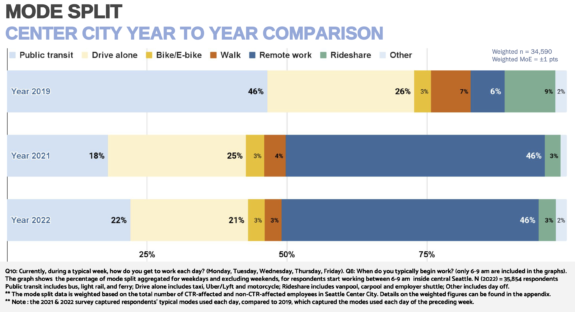 Commute Seattle dramatically expanded its annual analysis of work trip survey data, finding a wealth of interesting data about how the city’s commute patterns have changed since the start of the COVID-19 pandemic.
Commute Seattle dramatically expanded its annual analysis of work trip survey data, finding a wealth of interesting data about how the city’s commute patterns have changed since the start of the COVID-19 pandemic.
The biggest change by far is that as of late 2022, remote work was more than seven times higher than before the pandemic, making up 46% of “commutes” to Seattle center city workplaces on average and more than 50% on Mondays and Fridays.
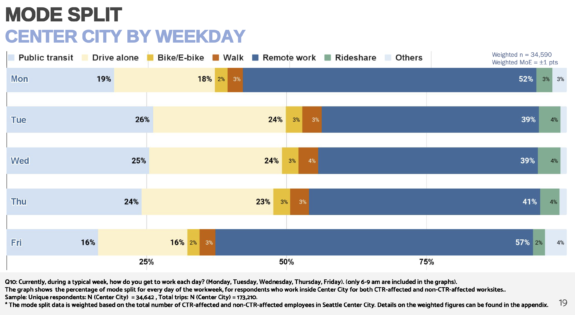 The data for biking is most notable for being rock solid and consistent while other modes saw major changes. Biking was 3% of commute trips to the Seattle center city in 2019, 3% in 2021 and it’s still 3% now. This means that biking has increased its share of non-remote work trips from about 3% in 2019 to about 6% in late 2022.
The data for biking is most notable for being rock solid and consistent while other modes saw major changes. Biking was 3% of commute trips to the Seattle center city in 2019, 3% in 2021 and it’s still 3% now. This means that biking has increased its share of non-remote work trips from about 3% in 2019 to about 6% in late 2022.
In one of the most fascinating charts in the whole 81-page document, you can see how commute habits shifted. It’s one of those charts that keeps being more interesting the more you look at it.
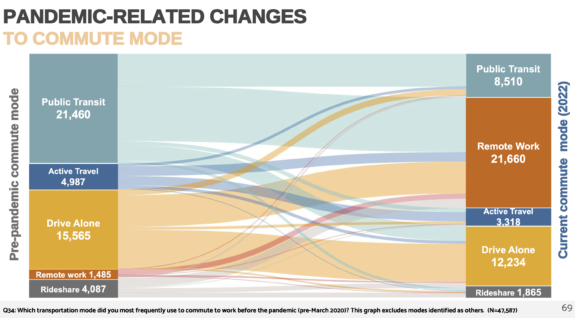 The vast majority of the new remote commutes used to be drive alone and transit trips, though a significant number were also people walking. In fact, of all the top-level changes, the decline in walking to work is perhaps the most surprising, down from 7% in 2019 to just 3% in 2022.
The vast majority of the new remote commutes used to be drive alone and transit trips, though a significant number were also people walking. In fact, of all the top-level changes, the decline in walking to work is perhaps the most surprising, down from 7% in 2019 to just 3% in 2022.
Combined with sharp increases in traffic deaths and injuries to people walking, this commute data should be setting off major alarms within SDOT and local elected officials. Seattle is in the midst of a total crisis for walking, which is the lifeblood of healthy neighborhoods and commercial districts. It deserves a huge response, comparable to how we respond to problems with major bridges mostly used by people driving cars.
Speaking of cars, drive alone trips are down to a measly 21% in the Seattle center city. To put that in perspective, 50% of center city commuters drove alone in 2000 and 34% did so in 2012. The drive alone rate to downtown Seattle has collapsed, which is a great thing. It’s long past time for our streets to reflect this reality.
Unfortunately, transit has seen the biggest decline since 2019. At 22%, people are using transit to commute to the center city at a lower rate than they did in 2000. A remarkable 46% took transit to center city jobs in 2019. There is a lot of room for a comeback, but bus service especially needs major improvements to restore service levels and reliability.
Bike commutes that shifted to remote work were offset by transit and drive alone commuters who took up cycling to work during the pandemic. And for the first time, Commute Seattle separated out e-bike use, which already makes up a significant percentage of bike trips. This data aligns well with the pandemic bike boom that essentially emptied out bike shops across the nation. It’s good to see that a lot of those new bike riders have stayed with it.
The chart also shows a big decline in so-called “rideshare” commutes, which includes carpools and employer shuttles.
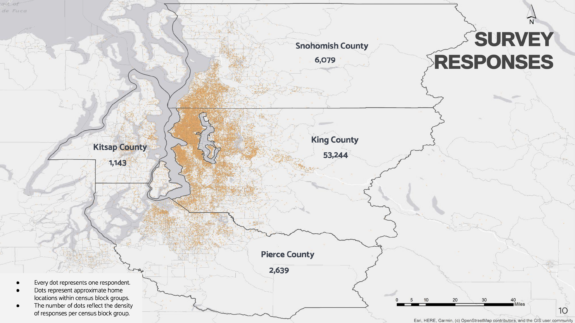 The report also has a lot of very interesting maps showing where work trips to Seattle originate. People come from all over, and some of these commutes are very long. Yikes.
The report also has a lot of very interesting maps showing where work trips to Seattle originate. People come from all over, and some of these commutes are very long. Yikes.
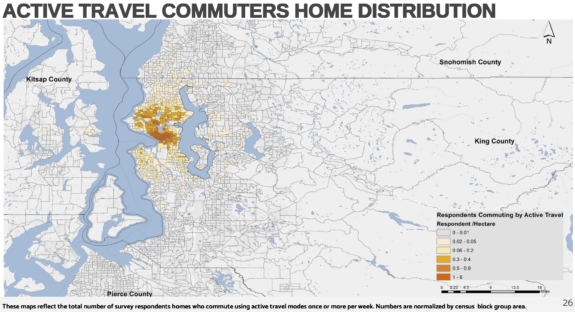 Perhaps not surprising, the bulk of “active travel” Seattle commutes (walking, biking, scootering, etc.) start in Seattle’s more walkable and bikeable areas in and around the center city and in north Seattle. Note how the active travel rates drop of quickly where safe streets also end. For example, you can almost see N/NW 85th Street on the map, which happens to be where many of the city’s sidewalks end. The rate also appears diminished in neighborhoods near highways or highway-style city streets like Holman, Lake City Way, MLK Way, Rainier Ave and 35th Ave SW. You can also see that places that lack quality bike routes are also less likely to have lot of active travel commuters.
Perhaps not surprising, the bulk of “active travel” Seattle commutes (walking, biking, scootering, etc.) start in Seattle’s more walkable and bikeable areas in and around the center city and in north Seattle. Note how the active travel rates drop of quickly where safe streets also end. For example, you can almost see N/NW 85th Street on the map, which happens to be where many of the city’s sidewalks end. The rate also appears diminished in neighborhoods near highways or highway-style city streets like Holman, Lake City Way, MLK Way, Rainier Ave and 35th Ave SW. You can also see that places that lack quality bike routes are also less likely to have lot of active travel commuters.
However, look at the light yellow all over the suburbs. Those are most likely long-distance bike commuters. It’s not an overwhelming number of people, of course, but they add up. They are also often in proximity to quality regional trails that connect to major job centers, such as the Interurban North, the Burke-Gilman, the 520 Trail and the I-90 Trail. Again, the lack of complete connections to regional bike routes headed into south King County is diminishing those trips. If there were a safe, comfortable and direct bike route to downtown Seattle from Renton, Tukwila, White Center and beyond, this map would look a lot different.
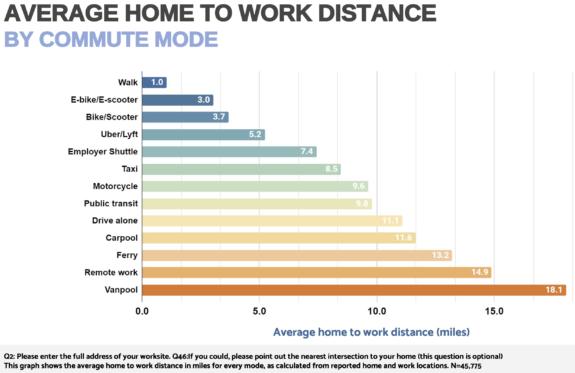 The average bike commute is 3.7 miles, which is actually longer than the average e-bike or e-scooter commute at 3 miles. I suspect that the e-scooter riders are bringing the average down since we know from micromobility data that bike share rides are significantly longer on average than scooter share rides. But it could also be that those long-distance bike commuters are still more likely to be riding pedal bikes than e-bikes, and they pull the biking average up. I’m just speculating, though.
The average bike commute is 3.7 miles, which is actually longer than the average e-bike or e-scooter commute at 3 miles. I suspect that the e-scooter riders are bringing the average down since we know from micromobility data that bike share rides are significantly longer on average than scooter share rides. But it could also be that those long-distance bike commuters are still more likely to be riding pedal bikes than e-bikes, and they pull the biking average up. I’m just speculating, though.
Knowing that people are willing, on average, to bike 3.7 miles to work should be instructive to SDOT and other regional transportation agencies. There are a lot of homes within four miles of major employment centers that do not have high rates of biking due to lacking quality bike routes or major streets that are hostile to walking and biking. Investing in safe streets will not only prevent deaths and injuries, but it will also result in increased walking and biking trips.
This is perhaps a good time to talk about the limitations of this data. Because it comes from Commute Seattle, a commute trip reduction organization, the bulk of their data comes from larger employers. It is not perfectly representative of all workers. But beyond that, it is not at all representative of non-work trips, which make up most trips in the city. They do have some questions in the survey about non-work trips, but the base of respondents is still people who work for large companies. They got more than 64,000 responses, 47,000 of which were from center city worksites. Only 36% of survey respondents rented their homes, whereas 50% of Seattle residents are renters. Only 4% of respondents were Black even though Black people make up 7% of the city’s population. So while 64,000 responses is a lot, the data does have a skew that’s worth keeping in mind. But the sheer size of the sample has done a lot to mitigate that skew. For comparison, the 2021 survey sampled 4,371 people.
If you dig through the survey results (PDF), please share your insights in the comments below. There’s a lot to unpack.












Comments
2 responses to “Commute Seattle survey: Driving, transit and walking down, biking unchanged, and remote work way up”
I’m not too surprised with the data, but I think it is important. Working from home has taken over a big share of the “commuting” to downtown, jumping by 40%. It took roughly 24% from transit, 5% from driving, 6% from rideshare and 4% from walking (go figure).
The travel distance is also important. The average remote worker lives quite a ways from downtown. Only vanpool riders come in from that far away (and vanpool use is rapidly diminishing). My guess is the high number of vanpool riders is the result of a very big system in Snohomish County. In any event, the data shows what is intuitive — the farther you are from work, the more likely you are to telecommute. This has very big ramifications for our transit system.
I’m also not that surprised at the data for biking. But it is important to consider that this data is for downtown. I’m sure the numbers get higher for other places (e. g. the UW). It is also very important to remember that this is just looking at commuting. Commuting is only a small portion of the trips that are taken on a regular basic. Again, biking likely represents a bigger portion of the trips if you are looking at trips to the grocery store, restaurant, clinic, etc. It is important that we keep improving the bike infrastructure and transit system at the same time. They go together.
This is stuck out to me
“Over 75% of the trips that Seattleites take to grocery stores, healthcare, and school pick-up and drop-off are done by driving alone. We also take more of these trips in a week than we do from home to work.”
Remote work is here to stay and in a city where transportation accounts for 60% of ghg emissions and is resulting in an increasing amount of deaths this number is the one we should be focusing on.
A lot of attention has been placed on the housing component of the 2024 comp plan which it should but we also need a serious conversation about how we get commercial space focused on daily needs like groceries and health/care into areas where the do not exist now. Restaurants and breweries are great but need to figure ways to encourage more small grocery stores and pharmacies that can daily needs. It is also imperative that we expand commercial space like corners stores across the city while also making it easier to bike and walk to existing commercial strips.
We also need the city to invest in preexisting commercial centers like Columbia City, Mnt Baker, Fremont and Raveanne. Better sidewalks that allow for cafe seating, more bike parking and improved bus stops are not just a climate and transportation solutions it’s also great for small businesses.
The 9 to 5 commute is dead. We need multimodal transportation and zoning that meets the reality of the post Covid world.